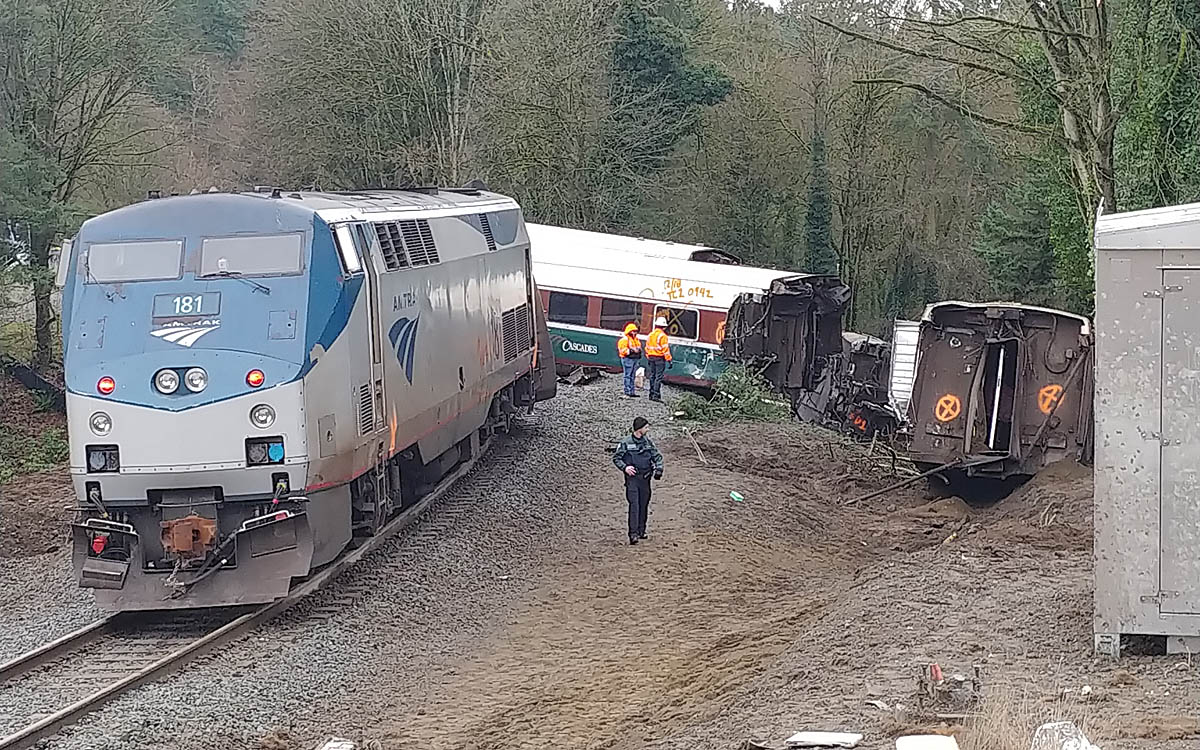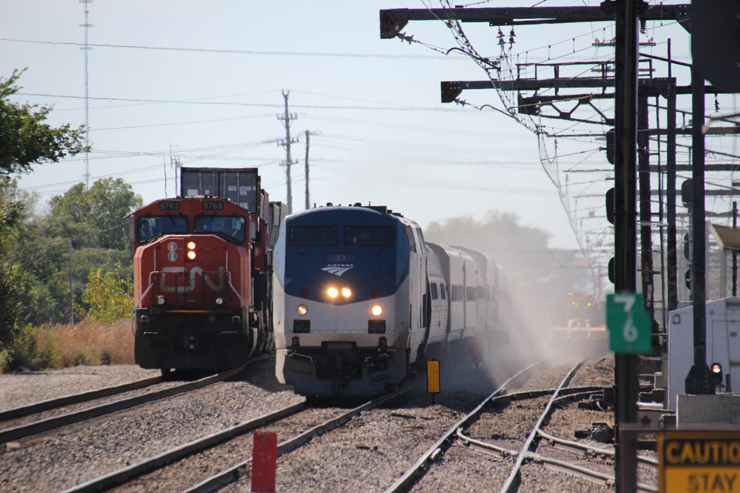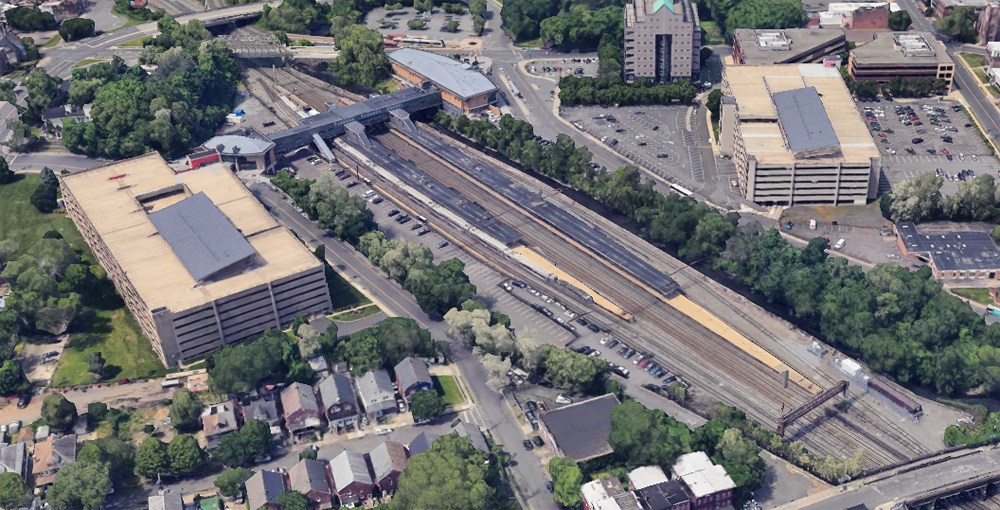TACOMA, Wash. — The engineer at the controls of an Amtrak train involved in a fatal Washington state derailment in 2017 has sued the passenger railroad, alleging that he was not properly trained.
On Jan. 21, attorneys for Steven Brown filed a lawsuit in Pierce County District Court seeking damages resulting from the derailment of Amtrak Cascades train No. 501 in December 2017. The derailment killed three people and injured dozens more. It occurred during the inaugural run on the Point Defiance Bypass, a new alignment meant to speed up the trip between Seattle and Portland, Ore.
According to investigators for the National Transportation Safety Board, the train derailed when it entered a 30-mph curve at 78 mph, sending a locomotive and cars off a bridge and on to Interstate 5. Investigators said the engineer was unfamiliar with the new route and the new Siemens Charger locomotive leading the train [See: “NTSB says multiple state and federal agencies failed in 2017 Washington state crash,” Trains News Wire, May 21, 2019].
Positive Train Control was not in use on the route at the time of the wreck.
In the lawsuit, attorneys for Brown alleged that Amtrak had acted negligently when it failed to properly train the engineer on the new route and that he and others were not given a sufficient number of familiarization runs on the Port Defiance Bypass. The lawsuit also goes on to blame a number of nameless individuals only identified as “Does one through fifty.” The attorney states that they will file amended complaints as those individuals are identified.
“As a consequence of the Defendant’s negligence and carelessness in violation of laws and regulations, the Plaintiff has suffered hearing impairment, hearing loss, pain, anxiety, general and special damages, diminishment of earning capacity, loss of enjoyment of life, and general damages yet to be determined,” the suit reads.
Brown is not the first person involved with the wreck to take Amtrak to court. In September 2019, a jury awarded three passengers $17 million and in November another jury forced Amtrak to pay a 20-year-old woman who was on the train $4.5 million.















It’s always someone else’s fault isn’t it; it’s never your own. I do not know any particulars so forgive me if I say something that doesn’t make sense. When I am the pilot in command and get in the cockpit, I am the FINAL authority for the safe operation of the aircraft. As a lot of aviation standards and practices seem to mimic railroading, I feel the engineer has final authority whether the train moves or not (especially when only one person is in the cab). I can try to deflect all the reasons why I failed in my task and an accident resulted; but I am still responsible. I don’t like “It’s not my fault” to escape responsibility. You can always decline and maybe lose your job, or you can do what you know you are not capable of, even though you may be technically qualified, and hope you get lucky. If you are not; don’t worry, some lawyer will get you off citing it wasn’t your fault…it was somebody else’s (just like Lac-Mégantic)
Was the engineer alone in the cab? When I worked for SCL in the mid ’70s any lineside signals or signs would be called out and acknowledged/repeated by a second person in the cab (fireman or brakeman. yes, we still had firemen then!) This was to confirm what the signal aspects were (and also to make sure that the head end crew were awake on those 3 a.m. runs). Anyway, for an inaugural run, there should have been the road foreman on board the engine.
I was ready to comment that he should have refused to run the train, saying he had not been properly trained and qualified. I see others have the same idea. BLET is a strong union and if all the engineers who were “trained” to run the route spoke up and said no, the union would have protected them. Sounds like they were not, a bunch of engineers in a cab at night and some in the rear cab is not good training. If the route was flat and no curves or hills, maybe, but not on this route. And a conductor should not have been in the cab being trained by someone who did know the route yet. No distractions on unfamiliar territory. I did hear that the Fed money was about ready to expire and there was a push to get the trains running.
Bartley Pickens,
“Third World Airline” training is not up to the standards of Western Carriers, I grant you that. However, I argue that it does not diminish the “you don’t know what you don’t know” point, and may in fact strengthen that part of my argument. Those aircrews saw themselves as fit to fly those airplanes. There is no evidence of them attempting to complain to their union (if they had one) or management. Then they flew two perfectly airworthy and functioning aircraft into the ground when something they did not know about came up.
I do find weakness in the argument that the engineer “should have foreseen” what could happen. Hindsight is 20-20 after all. If others were in the cab taking some of his attention, the risk of him missing one of the cues increased exponentially. That’s why airlines enforce “sterile cockpits” during key phases of flight – because chatter was found to lead to mistakes which led to experienced aircrew crashing airplanes.
It is entirely possible, under the distraction case, that this engineer could have run the line 1000 times and still made the same error – this is why we now have PTC. However, had he been more familiar, he would also have more landmarks to look for, and he could have caught himself when he lost situational awareness, reducing the chance of a wreck. That is where the lack of proper training becomes a plausible, and perhaps likely, factor. Along with it, the realization that he may not have had real reason to think there would be any safety issues with running that fateful morning.
I can’t say much do to my current employment. But in most of the comments here I see a lot of ignorant and uninformed comments in regards to what goes on in the railroad industry.
Mr. Christmas – The transition training of Third World airline pilots is woefully under the standard required by US carriers with the same equipment. For this reason alone, this fails as a “parallel example”, IMO. Many of the comparisons in earlier comments are on the mark for calling out the engineer’s simple blame shifting on the order of that seen on an elementary school playground. This engineer had a clear and easy out to declare himself unqualified on the route/equipment and his union would have backed him to the hilt.
Condolences to Mr. Fowler for the loss of his friends.
There are definitely times when one does not know that they are under-trained until after the worst occurs. It follows the old sage wisdom: “you don’t know what you don’t know”.
With regard to “not seeing a 30 mph curve coming” and “missing a speed reduction sign”, etc, I suggest a quick flip through the history of NTSB incident reports. Human error and loss of situational awareness are such a resounding issues, that the NTSB almost always finds some form of either – or both – in their investigations. Countless times, train crews, airline pilots, stagecoach drivers, etc have found themselves in situations that up until that point, they could not foresee, and for which training did not cover.
A painful parallel example is the 737MAX MCAS issue. The solution to runaway MCAS is extremely simple: cutout the stabilizer trim. The Lion Air and Ethiopian crews certainly knew to cutout Stab Trim in runaway trim conditions, but were quickly confronted with an unforeseen scenario where their training did not help. They crashed their airplanes. Today, not only will Boeing be fixing the MCAS, but they’ll also be adding additional training. The two flight crews found new holes in the “swiss cheese”, so now Boeing and the FAA are plugging them.
This engineer appears to have found the same fate.
I will keep to myself personal opinions on this matter, but I would like to throw that out there, based on the discussion below.
One thing that should be noted. Railroad workers do not come under workmen’s compensation. They come under the Federal Employers Liability Act (FELA) of 1908. When an injury occurs, the railroad can and usually offers a monetary settlement to the injured employee. The employee has the choice to accept the claim. If he doesn’t like the amount offered, and negotiations have failed to produce a settlement, his only option is to sue to get the amount he wants. Or if the railroad doesn’t offer any payment, which may be what happened here, again the employee’s only option is to sue. In this case, we don’t know which is the case here: that is, a payment was offered and rejected or no payment was offered.
The lawsuit is made to prove that the railroad was either partially or fully negligent in causing the injury. Then a jury gets to decide There is no set schedule of payment as there is in workman’s compensation.
If you read the second to last paragraph, it uses the wording hat the Defendant (the railroad among other) was negligent. So this is definitely a FELA lawsuit.
Likely I missed it but who was actually in the engineer seat? Was the qualifying conductor in the engineer’s seat, and why on this first trip would the engineer be required to post another person while he was still learning the route? I think he may have a case account of having a poster in the cab. But, I think Amtrak can counter sue him and likely will sue him, along with a number of injured persons. Amtrak should have had a Road Foreman of Engineer, a qualified manager on the job.
Mister Hull:
I cannot comment on ongoing litigation.
The above comments are generic in nature and do not form the basis for an attorney/client relationship. They do not constitute legal advice. I am not your attorney. You don’t need a criminal lawyer. You need a -> Criminal <- lawyer.
My two best friends, Jim Hamre and Zack Willhoite died at least in part because of Mr Brown’s train handling. There were many issues here besides pre-trip training, including the integrity of the Talgo Series Six trainset, the number of warning signs, the decision to not redo the infamous curve, etc. Blame exists on so many levels, but I mourn, remember and miss my friends and find this lawsuit saddening.
Mr Brown has escaped criminal negligence charges. Should he, perhaps, be satisfied? But I also understand the weight that has fallen upon him and have no animosity towards him either. Two years on the whole thing is just so sad. Somehow we need to get past recriminations on all sides and focus on a safer future.
When he was called by crew management and at anytime before he got in the cab, he could have said “no, I’m not qualified, I won’t do it. A Road Foreman should have been in the seat.
I believe I read somewhere that the reduce speed limit sign was over 2 miles from that curve. If you have knowledge of that or some other distance feel free to comment. If is in fact the case then that’s part of the problem. Even at 80 mph there’s alot that can happen in 2 miles.
Ms. Harding?
Wow. That’s crazy. Like the man who kills his parents and then throws himself on the mercy of the court because he’s an orphan.
What a load of crap?
Kinda’ like a drunk driver suing the people he hit for being on the highway at the same time.
I can’t comment on the merits of his case, I can only say this: He should be careful what he wishes for. If his own bank account gets larger there’s a whole lot of people who would want to go after him. If he thinks he was only acting under the direction of the company and he’s shielded from liability for his own negligence, well, then, “Here come the judge”.
I wonder if this is a FELA claim?
If the engineer didn’t feel he was sufficiently trained did he tell his supervisor or did he only decide that after the crash?
How is it Amtrak’s fault that he totally ignored the speed limit sign???
My opinion(yes the world is full of opinions),
Employers should be taking care of employees thru workmans compansation. And further in civil litigation of accidents stand by their employees to shield them from adverse consequences. Yes sometimes employees do malicious things. In most cases though, an employee has made a horrible mistake. In this and in Philadelphia the company, if it has the resources, should be providing good legal counsel.
If you don’t stand by your employees in good times and bad, when things go really bad, who is going to go for the exit first.
Regardless of training, ( he had at least been in the cab over the he route once ), how does one not see a 30 mph curve coming.?
The engineer is foregoing a future civil trial against him where he might be found liable (as opposed to a criminal trial)
Actually Sound Transit is the responsible party for safety along the route, Amtrak is just the operator. But Sound Transit did not have a safety officer familiar with the route as they had never used it before.
Sound Transit admitted openly they didn’t even know they were on the hook for safety, which is a sign of a lax safety culture. I had read earlier that they hired a exec for safety after the wreck.
It was a swiss cheese of issues.
WashDOT owns the line.
Amtrak is the operator
Sound Transit is responsible for scheduling and dispatch (and safety)
No one was there to hold the engineer accountable to be ready except himself.
Honestly, I am curious how the engineers union would allow a brother to operate a train he neither had training for or a route he had never mapped or surveyed.
Trade unions typically do not allow untrained members to operate equipment without some form of overview. Like a machinist union or a heavy equipment union. They don’t just let anyone jump in and operate a 45 ton crane.